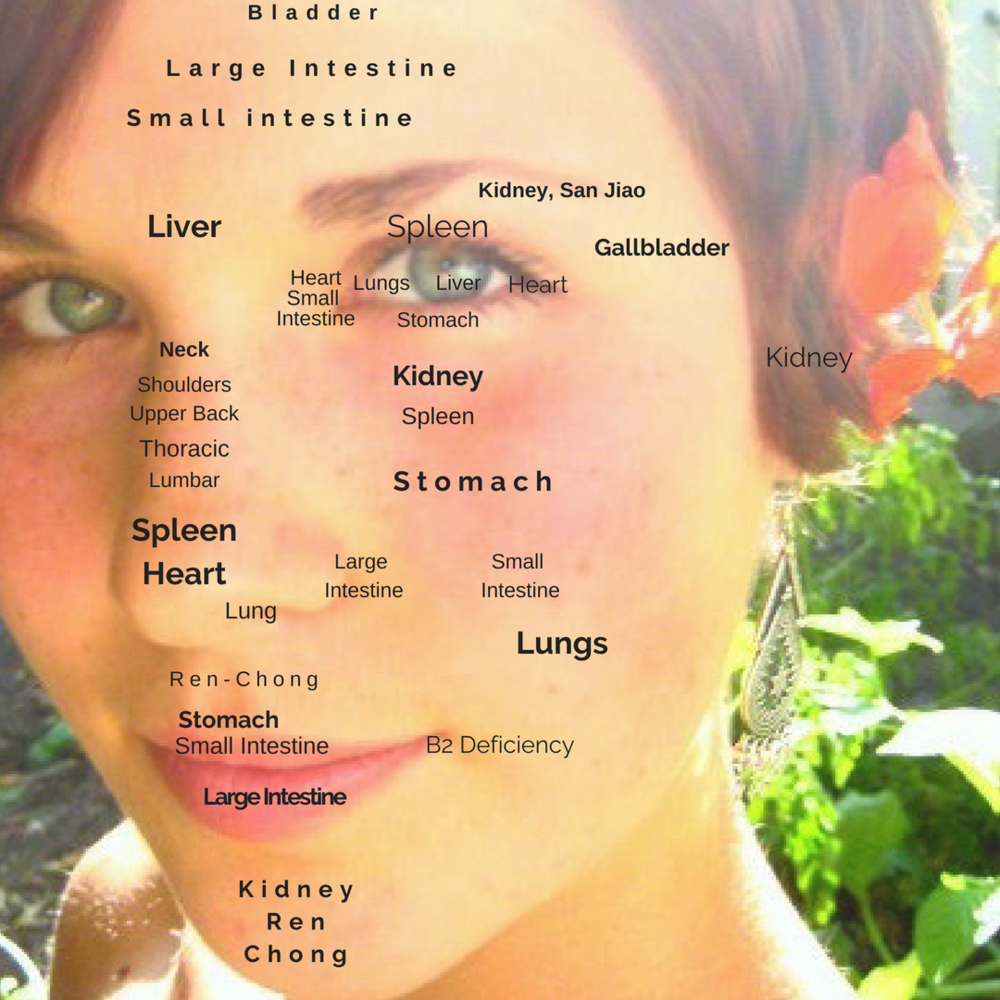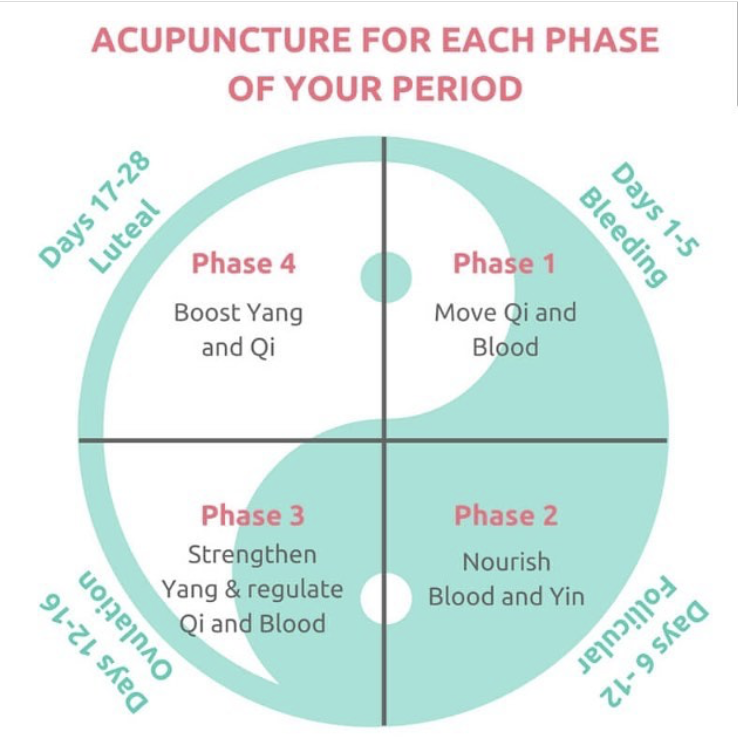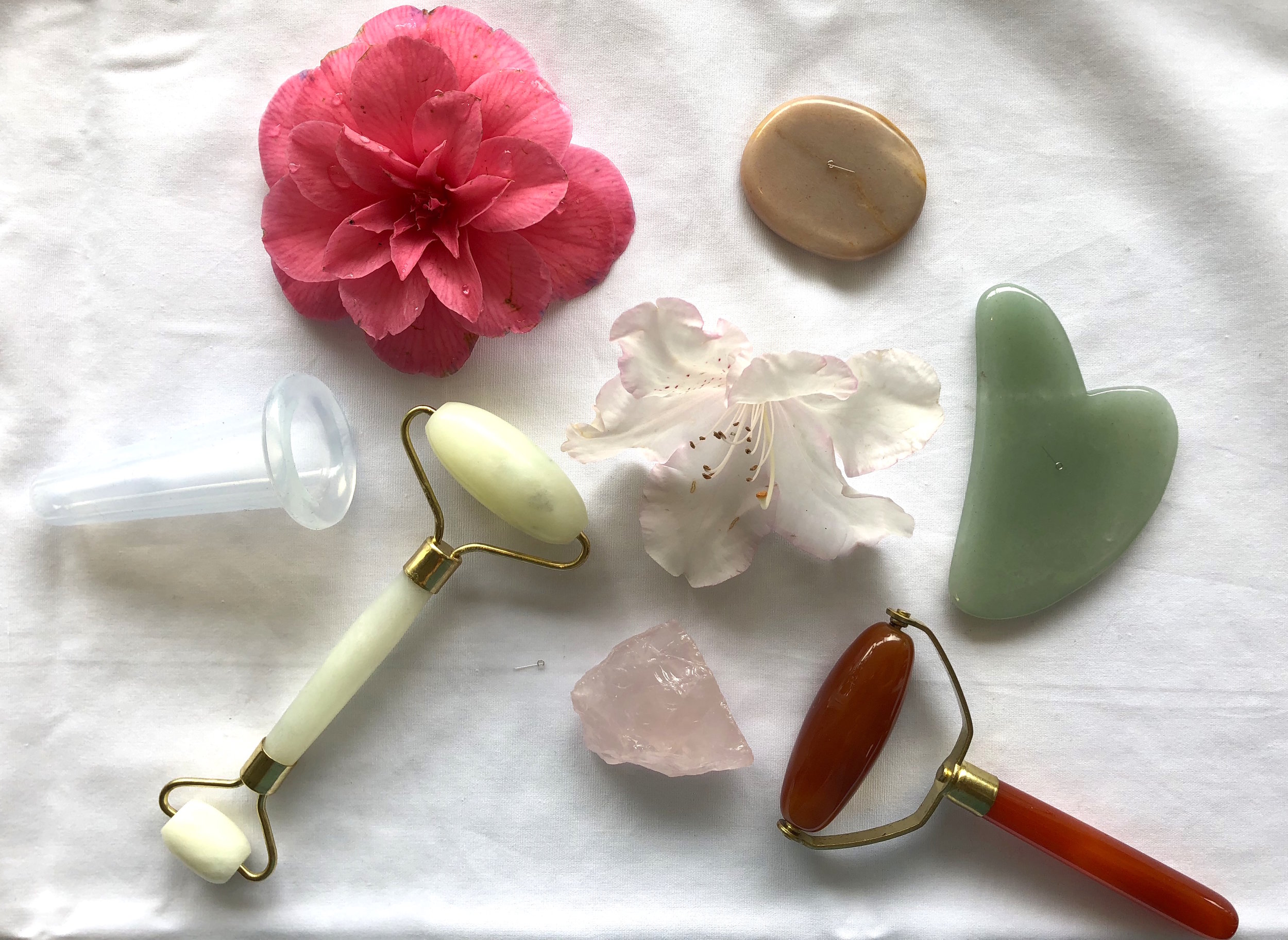Nutritional cycling is an effective way to balance, promote, and optimize hormone health throughout menstruation, pre-ovulation, ovulation, and post-ovulation. Specific essential fatty acids, nutrients, fiber, and phytochemicals have the potential to influence the production, detoxification, and ratio of sex and stress hormones as they wax and wane throughout the four phases of the menstrual cycle. In addition, cycling offers plant diversity for gut microbiome health and nurtures lifestyle routine.
“If there is lake of routine in life how can we expect our bodies to maintain routine or rhythms.” – Claudia Welch
Nutritional Cycling Guideline
For those without a menstrual cycle, follow the guidelines below according to the phases of the moon as one’s hormone cycle is interconnected to the ebbs and flow of nature. The gravitational force and light of the moon encourage hormone balancing.
You can expect positive hormonal shifts within 3 – 4 cycles when combined with weekly acupuncture treatments. Customized herbal therapy as advised from a medical herbalist is also recommended.
Note: Men can optimize hormone health through following the opposite timing of the seed portion of the nutritional cycling, for example:
- New moon to full moon: On the day of the new moon consume 2 tablespoons each of walnut and black sesame seed. Beyond this day consume 2 tablespoons per day of sunflower and pumpkin, and 1 tablespoon of hemp seed.
- Full moon to new moon: Focus on 2 tablespoons each per day of flax and hemp, and 3 tablespoons of chia seed per day.
Phase 1 | New Moon | Menstruation (Yin) | Day 1 - 7
“I set my intention; I feel my intention in my body. I reflect with thanks. I rest. I restore.” - Ezzie Spencer
This is the beginning of the follicular phase of a woman’s cycle. Hormones decline and bleeding occurs as the uterine lining is cleared through the vagina.
As hormones decline, focus on stillness, rest, warmth, gentle walks in nature, and nourishing self-care. Consume blood-building foods to replenish and restore, such as: grass-fed red meat, grass-fed gelatin, bone broth, berries, beet, black rice, black beans, coconut aminos, unsulfured blackstrap molasses, and dark leafy greens.
Increase qi regulating foods to reduce cramping. Prepare cooked, warm foods, sip on honey-ginger-lemon tea infused with a sprig of fresh rosemary, and incorporate ginger and scallion into soups and stews with easy to digest vegetables and protein.
Reduce arachidonic acid rich foods, a precursor to the inflammatory prostaglandin, PGE2, to ease menstrual cramps and PMS. To do so limit intake of saturated fat (animal fats and dairy products, coconut, palm) to 1 serving of animal and 1 serving of vegetarian saturated fat per day.
Increase foods that contain the antispasmodic muscle-relaxing prostaglandins, PGE1 and PGE3. Choose from omega 3 rich wild salmon, halibut, cod, sardines, and chia seed. Enjoy 2 tablespoons of hemp seed and 2 - 3 tablespoons of chia seed per day.
Phase 2 | First Quarter | Post Menses & Pre-Ovulation | Day 7 – 14
“I take discerning action to support my intention. I trust the perfect intention is coming into form at the perfect time.”- Ezzie Spencer
During the follicular phase of the cycle the pituitary gland begins making FSH (follicle stimulating hormone) and LH (luteinizing hormone) to simulate the growth of new follicles (eggs) in the ovaries. Follicles produce estrogen, which causes the uterine lining to grow in preparation for receiving an egg from ovulation, and cervical fluid increases. Note: Approximately one week prior to ovulation estrogen starts to peak.
Yin slowly starts to increase again after blood loss and yang promotes the growth of follicles. Boost blood and yin production by consuming heme iron-rich protein foods, with yang-promoting fresh green herbs, for example grass-fed liver pate with onion, garlic, basil, and rosemary.
1 - 1 1/2 weeks prior to ovulation (day 3 – 7 to 14) start to consume 2 tablespoons of fresh ground flaxseed per day. Phytoestrogen plant compounds (phytochemicals) in flax called lignans, its fiber content, along with cruciferous vegetables (broccoli, cabbage, etc.) will help to detox unsupportive estrogen and other hormone metabolites via the digestive tract.
Phytoestrogen-rich foods such as flax, maca, chickpeas, and tahini, contain weak estrogen-like activity, meaning these foods can support healthy estrogen production when needed. Increasing these additional sources of phytoestrogen foods 1 to 1-1/2 weeks prior to ovulation (day 3 – 7 to 14), can support your second phase; for example, adding hummus (chickpeas or lentils and tahini) to a steamed veggie and protein bowl.
Phase 3 | Full Moon | Ovulation | Approx. Day 14
“I move ahead with my intention now or accept that my intention was not the best at this time. I release it, and I course correct now. I feel grateful that my intention is coming into form in the perfect way. I receive with gratitude.” – Ezzie Spencer
High levels of estrogen trigger a surge of LH from the pituitary gland. This stimulates ovulation whereby one of the ovaries releases a mature egg from the most dominant follicle, which flows into the fallopian tube. The remainder of the ruptured follicle, called the corpus luteum, secretes progesterone.
Yin energy is at its peak and yang energy begins to rise. Physical, social, and mental activity increase as energy levels rise. This is a good time to proceed with something you’ve been putting off for a while due to lack of courage.
Intentions during this phase are to nourish essence, strengthen the kidneys, and regulate the ren and chong meridians. Seafood, nori and dulse, berries, walnuts, and black sesame seeds help to strengthen the kidneys. Slightly decrease your protein portions and increase vegetables and fruits, both raw and steamed. Carbohydrate intake can increase as activity levels naturally increase during this phase to 1 week prior to menstruation.
Phase 4 | Last Quarter | Post Ovulation and Pre Menses (Yang) | D. 14 – 35
“Now that I am receiving my intention I give back from a place of abundance.” – Ezzie Spencer
The corpus luteum shell continues to secrete progesterone, supports the uterine lining, and causes body temperature to rise throughout the luteal phase. Estrogen slowly increases as well. Progesterone reaches its peak around day 19 – 23.
The egg that was released during ovulation phase stays in the fallopian tube, which helps thicken the lining of the uterus to prepare for a possible pregnancy. If the sperm does not impregnate the egg during that time, the egg disintegrates and the menstrual phase resumes.
Yang energy rises as progesterone levels increase relative to estrogen. Social, physical, and mental energy are at their peak from approximately day 14 - 23. The body’s digestive fire is stronger during this time and so meat consumption can be increased. Now is a good time to try to re-introduce foods that have been eliminated in the past.
Consider incorporating GLA rich borage or evening primrose oil into your supplement regimen from day 14 to the first day of your period to help reduce PMS symptoms. To support progesterone production during phase 4, consume foods high in zinc, vitamin C, vitamin E, and vitamin B6. To prevent and ease cramping, eat magnesium rich foods.
- Zinc: seafood, red meat, pumpkin seed, and hemp seed.
- Vitamin C: camu camu powder, bell pepper, grapefruit, orange, broccoli (florets and stalk), strawberries, kohlrabi, brussels sprouts, snow or snap peas, cauliflower, parsley, cabbage, butternut squash, and berries.
- Vitamin E: avocado (1/2 – 1 per day), sunflower seed, almonds, spinach, Swiss chard, asparagus, broccoli, olives, olive oil, berries, and winter squash.
- Vitamin B6: liver, duck, game meat, salmon, spinach, and avocado.
- Magnesium: pumpkin and hemp seed, spinach, swiss chard, buckwheat, halibut, dark chocolate (75% +), butternut squash.
As hormones start to decline approximately one week prior to menstruation, intuition and an inward pull towards introversion occurs. PMS and lack of menstruation can be a signal to slow down and to reflect on your relationship with yourself and others. One week prior to your period increase gentle self-care such as castor oil packs, journaling, soothing hobbies, massage, and introspection.
The goal pre-menses is to move liver qi to prevent stagnation. Avoid cold, raw foods, and focus on wild caught fish, cooked green and yellow-orange veggies, soups, stews, and chai tea. Support yang with basil, sage, thyme, and rosemary, dill, fennel, garlic and ginger, chai spices, lamb, venison, and quinoa.
Again, reduce arachidonic acid rich foods, a precursor to the inflammatory prostaglandin, PGE2, to ease chronic menstrual cramps and PMS. Limit intake of saturated fat (animal fats and dairy products, coconut, palm) to 1 serving of animal and 1 serving of vegetarian saturated fat per day.
Increase foods that contain the antispasmodic muscle-relaxing prostaglandins, PGE1 and PGE3. Choose from wild salmon, halibut, cod, and sardines, which contain omega 3 fatty acids (alpha linolenic acid) and enjoy 3 tablespoons of hemp seed per day, 1 week prior to menstruation.
Note: Hemp is the only omega-6 rich seed that has an optimal ratio of omega6 to omega3 fatty acids of 3:1. Hemp’s omega-6 transforms into gamma-linolenic acid (GLA) and stearidonic acid (SA), both of which are anti-inflammatory in nature, helping to prevent cramping and skin blemishes.
Nutritional Cycling Guideline Summary
Follicular Phase 1 | New Moon | Menstruation (Yin) | Day 1 - 7
- Sip on ginger-lemon-honey tea infused with a sprig of fresh rosemary.
- During this week plan to consume 2 servings of wild caught fish. If you don’t eat fish make chia pudding with warming spices and ensure you’re taking a quality algae omega-3 supplement.
- Small amounts of grass fed red meat in soup or stew, i.e. beef, water buffalo, or bison with easy-to-digest vegetables such as winter squash, zucchini, carrot, and spinach.
- Incorporate ginger, scallion, and coconut aminos into soups, stews, and warm veggie and protein meals. Try making a delicious ginger-scallion sauce -- google ‘ginger-scallion sauce’ by Momofuku for the recipe.
- Make recipes with grass-fed gelatin, such as black cherry juice-pomegranate gummies or zucchini cheese.
- Aim for 2 tablespoons hemp seed and 2 – 3 tablespoons chia seed per day from day 1 – 7.
- Dark berries, beet, dark leafy greens, black rice, black beans, and blackstrap molasses.
Follicular Phase 2 | First Quarter | Post Menses & Pre-Ovulation | Day 7 – 14
- Sip on red rooibos tea.
- Grass-fed (pastured) liver, onion, garlic, and fresh green herbs such as basil, rosemary, sage, and thyme to support yin, blood, and yang energy.
- Make chicken or turkey soup or stew with onion, celery, yam, asparagus, mushroom, and herbs to support qi and yin.
- 1 – 1 ½ weeks prior to ovulation (day 3 – 7 to 14): 2 tablespoons fresh ground flaxseed per day, chickpeas, lentils, tahini, and 1 teaspoon of maca per day incorporated into tea, smoothies, or porridge.
Luteal Phase 3 | Full Moon | Ovulation | Approx. Day 14
- 2 tablespoons each: ground black sesame seed and walnut.
- Salad with seafood or duck
- Duck or chicken egg. If you’re allergic to egg white incorporate the egg yolk into a smoothie or mayonnaise.
- Smoothies with dark berries, dulse or nori, spirullina, collagen protein, spinach, and ground black sesame/walnut. Add a little hot tea to balance the smoothie’s cooling nature. Cold foods (in nature and temperature) dampen digestive fire, increase stagnation, and depletes yang energy.
- Focus on steamed or pressure cooked vegetables, moderate intake of smoothies and salads, and protein.
Luteal Phase 4 | Last Quarter | Post Ovulation and Pre Menses (Yang) | Day 14 – 35
Post-ovulation, approximately day 14 – 22:
- Incorporate GLA rich borage or evening primrose oil into your supplement regimen from day 14 to the first day of your period. This encourages supportive prostaglandin production, which helps prevents PMS symptoms.
- Focus on nutrient-dense smoothies, hot n’ cold salads, stir-fry’s, and steamed or pressure cooked vegetables and protein. Meat consumption can be increased. - Consume 2 tablespoons of pumpkin and sunflower seeds, and 1 tablespoon per day of hemp seed per day.
- Eat ½ - 1 vitamin E rich avocado per day.
- Support yang building with basil, sage, thyme, and rosemary, dill, fennel, garlic and ginger, chai spices, quinoa, lamb, and venison. - Increase zinc, vitamin C, E, B6, and magnesium rich foods.
Pre-menses, approximately day 23 – 35:
- Focus on warm foods, such as roasted vegetable bowls with yang herb
- dressings, and soups and stews with protein.
- Throughout the day consume ginger-lemon-honey tea. To make, add 1 – 2 inches of fresh grated ginger root to 2 – 3 cups water. Bring to a light boil, turn off heat, cover and steep for 10 minutes. Add 1 tablespoon fresh squeezed lemon juice, optional pinch of cayenne, and 2 – 3 teaspoons maple syrup or raw honey to sweeten. This helps to move qi and prevents cramping.
- Limit intake of saturated fat (animal fats and dairy products, coconut, palm) to 1 small serving of animal and 1 serving of vegetarian saturated fat per day.
- Consume 2 servings of omega-3 rich fish throughout the week, such as wild salmon, halibut, cod, and sardines. If you don’t eat fish consume chia pudding with chai spices and take algae oil.
- Omit pumpkin and sunflower seed and increase hemp seed to 3 tablespoons per day.
Just the Seeds, Seed Cycling Summary
Essential fatty acids derived from seeds and other whole foods fats such as avocado play an important role in producing hormones. Nutrients, phytochemicals, and fiber in seeds also have their roles in producing and optimizing hormone health. When consumed at regular times throughout the menstrual cycle these components can help balance the ratio and detoxification of hormones.
Follicular Phase 1 | New Moon | Menstruation (Yin) | Day 1 - 7
- Aim for 2 tablespoons hemp seed and 2 – 3 tablespoons chia seed per day from day 1 – 7. GLA transformed from hemp and omega-3 fatty acid-rich chia help to ease cramping and any PMS related symptoms.
Follicular Phase 2 | First Quarter | Post Menses & Pre-Ovulation | Day 7 – 14
- 1 – 1 ½ weeks prior to ovulation (day 3 – 7 to 14): 2 tablespoons fresh ground flaxseed per day. Flax lignans and fiber helps to detox unsupportive estrogen during this estrogen-peak time, and other hormone metabolites via the digestive tract. Lignans contain estrogen-like activity, meaning it can also support healthy estrogen production when needed.
Luteal Phase 3 | Full Moon | Ovulation | Approx. Day 14
- 2 tablespoons each: ground black sesame seed and walnut to nourish essence, kidney health, and to supply phytoestrogens (sesame).
Luteal Phase 4 | Last Quarter | Post Ovulation and Pre Menses (Yang) | Day 14 – 35
Post ovulation, approximately day 14 – 22:
- Consume 2 tablespoons of pumpkin and sunflower seeds, and 1 tablespoon per day of hemp seed per day. These seeds are rich in zinc and vitamin E, which help to produce progesterone.
Pre menses, approximately day 23 – 35:
- Increase hemp seed to 3 tablespoons per day. Hemp is a balanced omega6:3 ratio seed and a source of GLA and magnesium, which helps prevent PMS symptoms.
References:
Mateljan, George. The World’s Healthiest Foods. Seattle, Washington: George Mateljan, 2007.
Chambial, Shailja et al. “Vitamin C in Disease Prevention and Cure: An Overview.” Indian Journal of Clinical Biochemistry 28.4 (2013): 314–328. PMC. Web. 11 Aug. 2017.
Dadkhah, Hajar, Elham Ebrahimi, and Nahid Fathizadeh. “Evaluating the Effects of Vitamin D and Vitamin E Supplement on Premenstrual Syndrome: A Randomized, Double-Blind, Controlled Trial.” Iranian Journal of Nursing and Midwifery Research 21.2 (2016): 159–164. PMC. Web. 11 Aug. 2017.
Bradbury, Joanne. “Docosahexaenoic Acid (DHA): An Ancient Nutrient for the Modern Human Brain .” Nutrients 3.5 (2011): 529–554. PMC. Web. 11 Aug. 2017. https://www.westonaprice.org/health-topics/making-it-practical/tripping-lightly-down-the-prostaglandin-pathways/
Phipps W, Martini M, Lampe J, Slavin J, Kurzer M. Effect of flax seed ingestion on the menstrual cycle. J Clinical Endocrinology and Metabolism 1993; 77(5): 1215-1219.
http://drtorihudson.com/articles/essential-fatty-acids-and-womens-health-part-1/
https://sites.google.com/site/miscarriageresearch/hormones-and-miscarriage/progesterone-research/how-to-increase-progesterone
http://www.webmd.com/vitamins-supplements/ingredientmono-954-vitamin+e.aspx
USDA nutrient database: https://ndb.nal.usda.gov/ndb/foods
Quotes: http://www.lunarabundance.com/




















